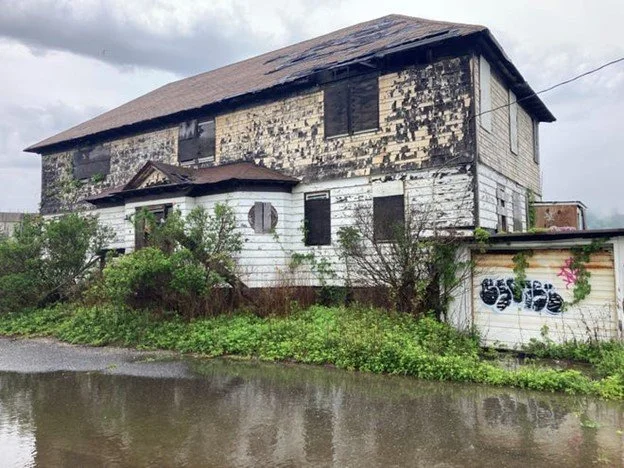Bulldozers coming? Government shutdown leaves fate of Sandy Hook landmark in the dark
HISTORY
Bulldozers coming? Government shutdown leaves fate of Sandy Hook landmark in the dark
Four-minute read
Asbury Park Press, 16 October 2025
An investor has emerged to save the historic Sandlass House at Sandy Hook, which the National Park Service plans to demolish.
Preservationists are concerned as a decision date from the National Park Service looms, but communication has ceased due to the federal government shutdown.
The Sandlass House is the last remaining structure from the Highland Beach Resort, which was a popular attraction in the late 19th and early 20th centuries.
SANDY HOOK -- The movement to save the historic Sandlass House — the final, crumbling vestige of a once-bustling resort near the entrance to Sandy Hook — has found an investor.
With the federal government shut down, however, preservationists are in the dark about what the National Park Service will do next as a decision date looms.
The park service, which overseas the peninsula as part of Gateway National Recreation Area, announced plans last year to demolish the house but agreed to first examine whether it should be spared as a “contributing structure” to the Fort Hancock and Sandy Hook Proving Ground Historic District — and thus entitled to landmark protection as outlined by the National Register of Historic Places.
In a July 2025 email, the National Park Service’s accountability office said the matter was under advisement, “with a resolution or response expected by the end of October 2025."
That time frame is imminent, but “we’ve got crickets right now,” said movement leader Frank Smith, who is vice president of the Jersey Coast Heritage Museum.
An investor emerges, but is ignored
The Sandlass House is last structure standing from the once-famous Highland Beach Resort, which was built by William Sandlass Jr. in 1888. The Highland Beach Gravity Railroad, one of the first roller coasters on the East Coast, was the initial attraction. In 1893, the house was built from the frame of the disassembled roller coaster.
The resort grew to include a merry-go-round, pavilions, restaurants, bars and storefronts, attracting as many as 20,000 people per day at its peak in the 1920s.
In 1962, New Jersey seized the resort through eminent domain. Eventually the Sandlass family would be paid $350,000, or $2.8 million in today's dollars, for the land and buildings. Starting in 1979, when the entire peninsula was turned into a national park, the Sandlass House served as a base for park rangers. The last ranger-tenant moved out in 2012, shortly before Superstorm Sandy rendered it uninhabitable.
Smith has pushed for the Sandlass House to be included in the National Park Service’s leasing program, which has gotten results at the northern end of Sandy Hook. There, former Fort Hancock buildings have been turned into vacation rentals, a general store and the thriving Mule Barn Tavern by individual entrepreneurs.
Gov. Phil Murphy backed Smith’s recommendation in a May 9 letter to Minka Sendich, the National Park Service’s acting superintendent for Gateway National Recreation Area. Additional support came from U.S. Rep. Frank Pallone, D-N.J., the Monmouth County Board of Commissioners, Sea Bright Mayor Brian Kelly, a joint resolution by the New Jersey Legislature, the Monmouth County Historical Association and the Monmouth County Historical Commission.
Get the News Alerts newsletter in your inbox.
Get alerted to the latest stories to stay on top of the news.
Delivery: Varies
Your Email
After a failed proposal by New York-based developer Stillman International to repurpose Fort Hancock’s 21 bayfront officers' homes into 80-plus apartments, the park service “is talking about bundling three properties at a time for anyone who’s interested in the leasing program, but we get no information at all about the opportunity to put the Sandlass House into leasing,” said Smith of the Jersey Coast Heritage Museum.
This is happening despite a commitment from an entrepreneur Smith described as “a local real estate investor with a longtime connection to Sandy Hook and the surrounding community” who is willing to fund the restoration of the landmark’s exterior and adapt the interior for commercial use, possibly as a bed-and-breakfast.
“So this is where we stand, thinking any day somebody’s going to call us saying the bulldozers are there,” Smith said.
'One minute to midnight'
Demolition during the federal shutdown is unlikely, but it could be teed up for when the government reopens. And it could be costly.
Smith said National Park Service employees informed him a few years back that demolishing the Sandlass House would cost $800,000. The point he’s tried to make over and over: Instead of the taxpayers footing that bill, why not give the private sector a shot at saving the landmark?
With the federal government shut down, no one from the National Park Service is available to answer the Asbury Park Press’ request for an update on the situation — what the status is on the “contributing structure” review and whether demolition is imminent.
Smith knows the feeling.
“I know right now the shutdown is complicating a lot of things,” he said. “I feel like we’ve got that temporary breathing room, but the shutdown could end next week. Over the years we’ve been playing this long game with them, but right now it feels like we’re playing at one minute to midnight.”
Jerry Carino is community columnist for the Asbury Park Press, focusing on the Jersey Shore’s interesting people, inspiring stories and pressing issues. Contact him at jcarino@gannettnj.com.




